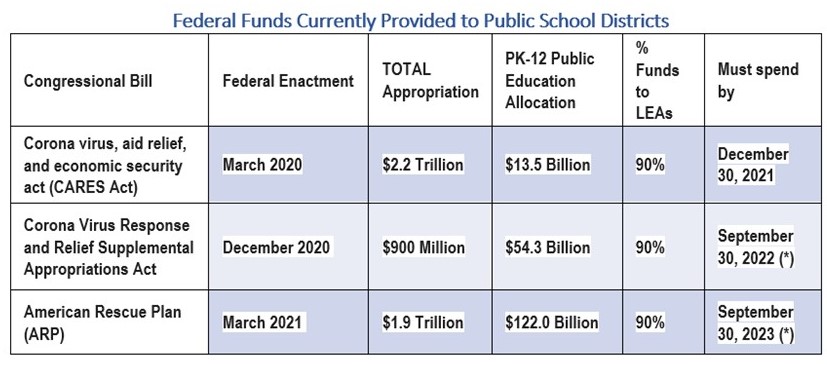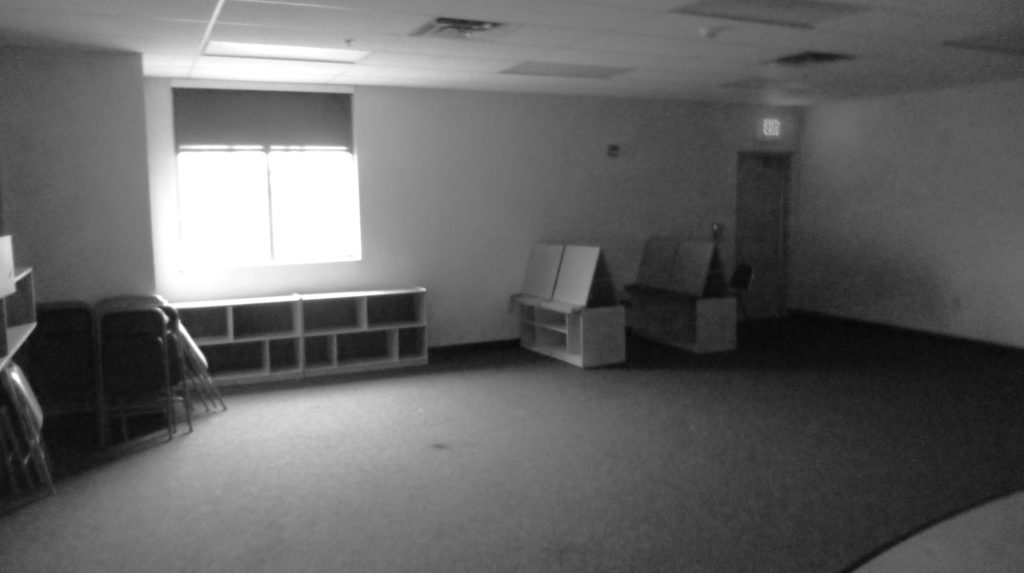In response to the tremendous demands that are on the nation’s public schools during this pandemic, the federal government has provided substantial response and relief funds to school districts. There is also explicit language in the Supplemental Appropriations Act and in the American Rescue Plan (ARP) allowing districts to use these funds on school buildings and grounds. There is confusion about how much of these funds should be for facilities and how to use them. This article contains the recommendations of the National Council on School Facilities to these questions.
The table below shows what was in the total appropriation and what went to states for school districts.

Additional funds were made available to the Bureau of Indian Education, outlying areas, and for homeless youth. There is a stipulation that 20% of the Local Education Agency (LEA) funds be set aside for use to reduce learning loss from the pandemic. The facilities allowable uses are just a part of the many ways districts can use their relief funds and there is not dedicated funding for facilities. So technically, except for the 20% learning loss set aside, all the rest of the funds could be spent on public school facilities. However, this is not what the National Council on School Facilities recommends.
A key foundation of these recommendations is the importance of planning and predictability for the facilities managers who must deliver and also improve the teacher and learning environments in schools.
These recommendations for budgeting for facilities represent best practices for states and districts that have been developed based on weekly webinar presentations and discussion on facilities operations during the pandemic. A key foundation of these recommendations is the importance of planning and predictability for the facilities managers who must deliver and also improve the teacher and learning environments in schools. These recommendations support the need to supplement what is too often inadequate maintenance and operations budgets and they emphasize the need for flexibility in which projects are prioritized because of the variability and complexity of conditions. Additionally, an economical, but important recommendation is to increase the capacity of state facilities offices for assessments, standards, data and technical assistance. Increased state capacity will go a long way to advancing the equity and efficacy of not only federal funds, but state and local funding.
Recommendation 1:
States should allocate at least 1% of their state reservation funding toward state level functions related to school facilities.
States should assist districts with facilities assessments and facilities data management and work to determine which operational standards should be applied at the state level. Additionally, states should identify resources and technical assistance to help districts get good value from their facilities related spending.
Recommendation 2:
Districts should allocate at least 15% of their federal Relief and ARP funding (excluding 20% for learning loss) for healthy school facilities.
Fortunately, the COVID 19 Relief funds and the American Rescue Plan have provided funding to school districts which can be used to help districts improve the health of their school facilities. The National Council on School Facilities recommends that school districts allocate at least 15% of the combined Relief and Rescue Plan Funding (excluding the 20% learning loss set aside) to the healthy operation of school facilities. Nationally, this would mean that districts would have at least $20 billion to reduce the deferred maintenance that inhibits the effective layering of facilities-related mitigation strategies advised by the Centers for Disease Control. Go to https://www.facilitiescouncil.org/covid19-general-guidance to see estimates of a 15% allocation of Relief and Rescue Plan funds by school district. This allocation will help address disparate impacts of the pandemic, since school districts with high levels of deferred maintenance and repairs are often also districts with high numbers and percentage of students from low income and minority communities.[1]

Recommendation 3:
U.S. Department of Education and State Departments of Education should encourage district flexibility in the use of federal funds.
The National Council on School Facilities recommends to the U.S. Department of Education and to the State Departments of Education that local districts be encouraged to use COVID relief funds to address a wide range of deferred maintenance and repairs in school buildings and grounds, including, but not limited to the specific facilities project examples included in the text of ARP.[2] This flexibility in the use of funds is critically important to ensure that funds meet local needs, that they are equitably distributed, that districts get the highest value from the funding available, and that districts can afford to sustain the improvements. The June 2020 GAO report on the nation’s facilities makes clear the wide range of deficiencies in schools.[3]
With Relief and ARP funding to PK-12 school districts, districts will be able to:
- Assess the condition of school facilities, including key equipment, systems, components, finishes, furniture and fixtures for near-, medium- and long-term requirements for healthy, safe, educationally appropriate, and environmentally sustainable buildings and grounds;
- Develop plans for routine and deferred maintenance to ensure equipment, systems, components, furniture and fixtures are working as they were designed;
- Develop a schedule and assignments or contracts for repairs on existing equipment, systems, and components to reduce deferred maintenance and repair backlogs;
- Repair, upgrade, or replace equipment, components, systems, furniture, and fixtures in support of healthy, safe, and equitable facilities;
- Modify buildings and grounds to support physical distancing—e.g., create outdoor classrooms, outdoor eating areas, and other outdoor spaces for school programs, in a manner that ensures physical distancing and gives students and teachers direct access to an abundant supply of fresh outdoor air during their classes and programs;
- Make limited capital improvements to address emergency system or component failures, and to support learning loss programming and mental health, for examples install air conditioning and add trees and other plants to school grounds, where they can be viewed from building windows and where they will be used by outdoor classes and programs.[4]
Difficult decisions will need to be made to equitably distribute funds, make sure spending is fiscally responsible, and actually make the teaching and learning environments healthier.
Recommendation 4:
States and districts should engage their staff and communities in setting priorities for healthy facilities-related improvements.
Difficult decisions will need to be made to equitably distribute funds, make sure spending is fiscally responsible, and actually make the teaching and learning environments healthier. Broad engagement of staff and communities and technical assistance from independent advisors will help ensure that these funds are well spent.
Recommendation 5:
Where local communities identify facilities improvements for healthy environments that exceed the recommended 15%, the U.S. Department of Education and States Departments of Education need to make clear that districts can spend in excess of the recommended 15% allowance for healthy facilities-related improvements.
Even with an allocation of 15% of the American Rescue Plan and COVID 19 Relief funds dedicated to ensuring healthy and safe indoor and outdoor facilities, the high levels of deferred maintenance and repairs of schools means that even this amount may fall short of meeting the urgent needs for reopening and operating healthy schools. Where local communities and districts determine facility improvement priorities above the recommended 15% allocation, districts should have flexibility to increase facilities related funding with other federal funds.

Recommendation 6:
Districts and states must be accountable for equity and advancing healthy school facilities by publicly reporting data on the scope, schedule, and amount of federal funding for healthy facilities improvements.
School districts and states need to provide publicly accessible and timely data on the scope, schedule, and cost of the federally funded projects on a school specific basis — being transparent about which schools got what spending from federal funds. Additionally, the districts and states need to identify a rationale for making projects priorities for COVID relief and ARP funding.
Recommendation 7:
School districts should use federal funds to supplement their FY2018 levels of operations and maintenance of plant.
NCSF recommends that states and school districts should be advised that if their maintenance and operations of plant expenditures do not fall below FY2018 levels, that districts will be credited with maintaining their effort.
[1] Growth and Disparity: A Decade of U.S. Public School Construction, 21st Century School fund, October 2006. Reopening Schools Safely and Equitably Amidst the COVID-19 Pandemic: School Facilities are Frontline Defense. Center for Cities + Schools, University of California, Berkeley, August 2020.
[2] (O) School facility repairs and improvements to enable operation of schools to reduce risk of virus transmission and exposure to environmental health hazards, and to support student health needs. (P) Inspection, testing, maintenance, repair, replacement, and upgrade projects to improve the indoor air quality in school facilities, including mechanical and non-mechanical heating, ventilation, and air conditioning systems, filtering, purification and other air cleaning, fans, control systems, and window and door repair and replacement.(Q) Developing strategies and implementing public health protocols including, to the greatest extent practicable, policies in line with guidance from the Centers for Disease Control and Prevention for the reopening and operation of school facilities to effectively maintain the health and safety of students, educators, and other staff.
[3] https://www.gao.gov/assets/gao-20-494.pdf ; School Districts Frequently Identified Multiple Building Systems Needing Updates or Replacement, GAO 20-494, June 4, 2020.
[4] Research conducted by William C. Sullivan, PhD, University of Illinois, Urbana-Champaign. https://www.researchgate.net/profile/William-Sullivan-15

